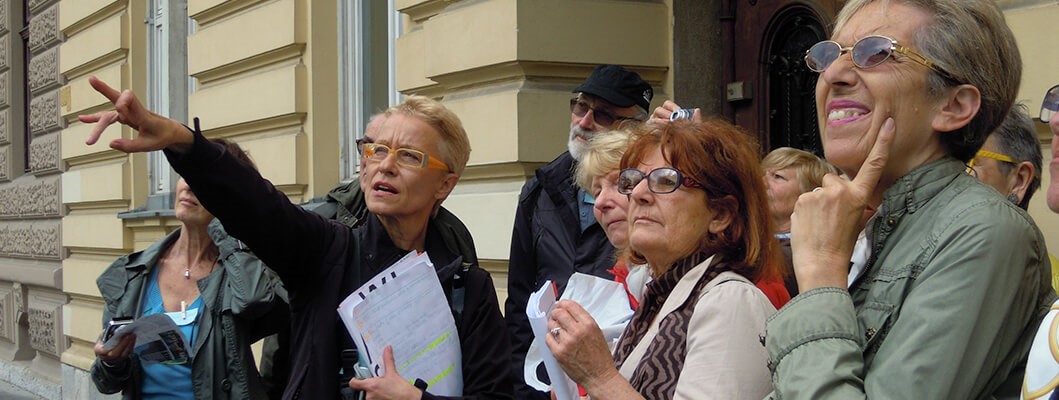Personal TownTours – Slovenian Version

Aim
The main value of the project was in the students involvement and their improved knowledge and skills. Moreover, older people are best interpreters of culture. (C.G. Jung). The idea behind this project was to pass on to later generations the knowledge and feelings about urban environment and buildings can produce, and to produce a kind of personal town guide in a way that has nothing to do with the usual sights and itineraries.Full Description
In the framework of the »Personal Town Tours«, a European Grundtvig project (2012-2014), seven older students from Slovenian Third Age University gained knowledge and learned methods for exploring and then introducing their town. Under the mentorship of the architect they decided on three thematic itineraries thus validating their already gained knowledge of architecture and urbanism. Moreover, in relation with the itineraries they produced their personal stories connected with their own life in the urban environment. They also added stories told by some other known or unknown townspeople, stories about the past living and working in some buildings or parts of the city. They collected personal recollections of anonymous inhabitants and their impressions about their town. To insert them in a more formal structure of knowledge about architecture and urbanism, which they continued gaining in their study programme on architecture and urbanism called “Squares, streets and buildings around us” run at Slovenian Third Age University.
Project partners:
- Slovenian Third Age University, Slovenia
- Center for General Scientific Continuing Education, Germany
- Università del Tempo Libero Città, Italy
- University for Adult and Senior Citizens, Italy
- Liga scriitorilor, filiala Timisoara, Romania
- AdAPh, France
- Rusenski universitet Angel Kanchev, Bulgaria
Step by Step Explanation
-
1
1st step: Analysing the interests of the participants and enabling them to describe their town using their experiential knowledge and non-formally gained information.
A presentation of a town is most successful when it comprises topics, preferred by the participants (future guides) in the educational programme. The participants are then encouraged to jot down their impressions and write about their personal experience of the town. Further, they bind them into recollections, impressions, thoughts and short stories. The participants’ attention is focused on thus gained new perspectives on the topics that they have already been familiar through their structured studies in their study circle.
-
2
2nd step: The collected stories are put into thematic clusters.
Various tours’ topics are possible and various combinations of single writings/stories. They are combined in such a way that experience and recollections of the guide are connected also to some current thematic.
-
3
3rd step: Collecting information and data regarding single topics is then deepened, enriched by personal stories of anonymous townspeople.
How to recruit respondents? By referring to our own social network and the social networks of our students (relatives, friends, ex co-workers, neighbours, …). Ways of collecting the data are adapted to single respondents: oral interviews or writing own stories and recollections.
-
4
4th step: Personal stories, put in clusters, binding single topics with formal data.
Stories are then studied from different perspectives, from the angle of different disciplines (i.e. architecture, urbanism, art history, spatial sociology, psychology). By inserting theoretical knowledge and data from professional literature and the knowledge gained in the study programme, stories become more credible.
-
5
5th step: Piloting single tours.
Participants prepared pilot tours where the planned itinerary and tour as a whole were tested, the tour was assessed from the point of view of the target groups. Assessed were the length of the tour, the details of the tour, the itinerary, the duration of the tour, and the participants exercised telling their stories.
-
6
6th step: Carrying out the tours.
The tours can be conducted for different target groups, each time the tour being adapted to the target group. As time goes by the tours can be modified, including various new experience, the knowledge of the target groups and their expectations, their changed or new interests.
Results
Implemented Methods
Exploratory research learning
Conducting a research and writing a research report are in themselves learning methods for those who are involved. Research reports have two main goals: to report and to persuade the audience of the report and call for action. Research groups are thus supposed to create such a report by asking themselves the following questions: (1) what is it that we want to say? (2) To whom do we wish to say it (the ‘target group’) and (3) why do we want to say it?
Descriptive ethnographic method
After having decided on three thematic itineraries the participants in the project described the three itineraries, buildings and urban places on the way. They also described people who were met in different institutions, like cafes, in the Opera house, in different stores, etc. They used the descriptive ethnographic method to this end.
Interviewing
The participants addressed friends, neighbours, students of the Third Age University, the inhabitants of Ljubljana. They interviewed them. They recorded the interviews which were mostly unstructured.



